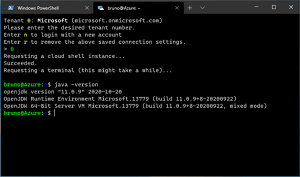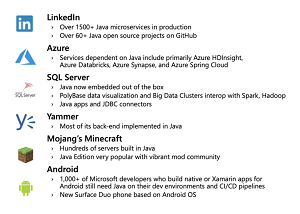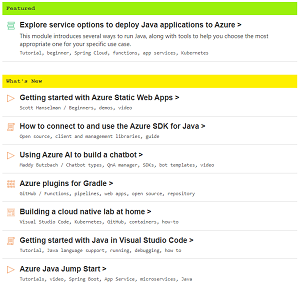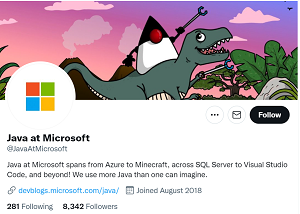News
Microsoft Pushes Java for Azure Development
Microsoft, which claims "We use more Java than one can imagine," is pumping up its Java push on several fronts, including promoting a bunch of guidance for using the popular programming language on its Azure cloud computing platform.
Earlier this year we covered the company's big Java push that was highlighted by the 2019 formation of the Java Engineering Group in its Developer Division and acquiring jClarity to optimize Java workloads on Azure, followed up by its own port of the OpenJDK, described as "a new no-cost long-term supported distribution and Microsoft's new way to collaborate and contribute to the Java ecosystem."
 [Click on image for larger, animated GIF view.] Microsoft Build of OpenJDK on Azure Cloud Shell in Animated Action (source: Microsoft).
[Click on image for larger, animated GIF view.] Microsoft Build of OpenJDK on Azure Cloud Shell in Animated Action (source: Microsoft).
Since then, the company hasn't slowed down, with its latest developer team newsletter demonstrating an obvious Java-on-Azure focus with multiple tutorials and other guidance.
The company's heavy use of Java and continuing promotion of the language for Azure computing comes even though the language is similar in many ways to its own flagship programming language: C#. The comparison between the two languages was detailed in the 2019 article "Key differences and similarities between C# and Java."
Here's what the article, published on the Western Governors University site, says about the two languages:
Java and C# are both object-oriented languages heavily influenced by C++. Their syntax and features have a lot of similarities, although C# has more features because it is newer. But while both languages depend on third party frameworks and reusable components, it is fair to say that Java has more frameworks than C# and is slightly more portable.
These languages have been around for a long time and it is important to understand that any application built using one language, can generally be built using the other language as well. But, when building applications in .NET framework, the language of choice usually is C#. So, for an application developer the choice of language depends on the need and the application’s platform.
However, when the application's platform is the cloud instead of on-premises .NET running on Windows as is typical in the Microsoft-centric dev camp, things change. Here, Microsoft champions Java. The reasons for this come in the Java on Azure site, which in reply to the "Why Java on Azure?" question lists these answers saying that developers can:
- Develop using tools and frameworks you love: Build, debug, and deploy Java applications on Azure using your favorite IDEs, including Eclipse, IntelliJ, and Visual Studio Code for Java. Use build and automation tools like Maven, Gradle, and Jenkins for your continuous integration and continuous delivery needs.
- Ship faster with fully managed services: Focus on building business applications, instead of managing your infrastructure. Take advantage of Azure App Service, Azure Spring Cloud, Azure Kubernetes Service (AKS), and Azure Red Hat OpenShift for hardware and software infrastructure management.
- Extend your Java applications: Quickly add services and capabilities, including managed MySQL, PostgreSQL, and SQL databases, performance monitoring, and secrets management. Connect your applications with integration services like Azure Service Bus with Java Message Service (JMS) support and Azure API Management.
- Take advantage of the Microsoft partner ecosystem: Get best-in-class solutions to bring your existing Java workloads to Azure and extend the functionality of your applications. Access a growing portfolio of Java-focused solutions, from unique managed hosting options with joint development and support to Azure Marketplace images for popular Linux distributions.
 [Click on image for larger view.] Java at Microsoft (source: Microsoft).
[Click on image for larger view.] Java at Microsoft (source: Microsoft).
Of course, the web is full of Java-vs.-C# (or.NET) comparisons, with many discussions taking place in a cloud context. A quick search shows three such cloud computing comparisons that all include Java and either C#/.NET/ASP.NET. The top-five rankings are:
- 1) Java, 2) PHP, 3) .NET, 4) Python, 5) Golang -- see here
- 1) Python, 2) Golang, 3) Ruby, 4) Java, 5) ASP.NET -- see here
- 1) Java, 2) ASP.NET, 3) PHP, 4) Python, 5) Ruby -- see here
So Java seems to be a safe bet for Microsoft, though the company of course hedges its bet with Azure for .NET developers guidance that focuses on the Azure SDK for .NET, along with offering SDKs for Java, JavaScript, Python, C++, Embedded C, Android, iOS and Go.
It's Java that is getting the lion's share of attention in the latest developer newsletter from Microsoft, though, with guidance such as:
- Explore service options to deploy Java applications to Azure: This points to the "Choose the right Azure service for deploying your Java application," a 25-minute learning module consisting of six units
- How to connect to and use the Azure SDK for Java: This points to the "Use the Azure SDK for Java," page published in February, a 5-minute read
-
Azure Java Jump Start: This points to a list of YouTube videos:
- Create a Java app on Azure App Service: This points to a same-named Quickstart
- Microsoft Certified: Azure Developer Associate: This points to the site for candidates for the Azure Developer Associate certification, designed to provide subject matter expertise in designing, building, testing, and maintaining cloud applications and services on Microsoft Azure.
 [Click on image for larger view.] All About the Cloud (source: Microsoft).
[Click on image for larger view.] All About the Cloud (source: Microsoft).
The newsletter is also available in a web page where interested developers can find many more articles, events and learning opportunities on a variety of topics, including some focusing solely on Java and some focusing solely on Azure and some no doubt at least mentioning both.
 [Click on image for larger view.] Java at Microsoft on Twitter (source: Twitter).
[Click on image for larger view.] Java at Microsoft on Twitter (source: Twitter).
Developers can keep track of Java at Microsoft at the same-named DevBlog and Twitter account, with the latter listing 3,342 followers as of this writing.
About the Author
David Ramel is an editor and writer for Converge360.